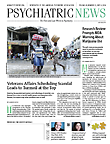For years, substance use has been known as a key factor mediating the intersection of mental illness and violence against self and others, but drugs and alcohol may be the more significant partner in that interaction.
“Only a small proportion of violent crime is committed by people with mental illness, but the role of substance abuse is important,” Edward Mulvey, Ph.D., emphasized at APA’s 2014 annual meeting in New York in May.
In a study of 208 defendants published in the September 2013 American Journal of Psychiatry, Mulvey and colleagues found that 58 percent had an Axis I or II disorder, most commonly a substance use diagnosis (47 percent). Only 4 percent had a psychotic disorder.
Clinical variables, like Axis I diagnoses, were not associated with either offense characteristics or case outcomes, they said. “So increased mental health screening would have little effect on the overall level of violence,” said Mulvey, a professor of psychiatry at the University of Pittsburgh School of Medicine.
Another study found that when symptoms and their severity fluctuated rapidly, individuals were 2.7 times more likely to act violently than when symptoms trended back to equilibrium. “An inability to regulate symptoms back to a ‘set point’ or equilibrium was linked with substance use, primarily alcohol,” he noted.
It would be valuable to combine advances in identification of high-risk groups with regular efforts to monitor changes in risk (especially substance use) to better manage the potential for violence, he said.
Drinking, Self-Directed Violence Linked
Alcohol plays a major role, but not always in a linear way, in violence directed against oneself, said Kenneth Conner, Psy.D., M.P.H., an associate professor of psychiatry at the University of Rochester.
About 37 percent of suicide decedents have acute levels of alcohol in their bodies, he pointed out. An alcohol use disorder increases the risk of suicidal ideation and planning. “But acute use increases suicide attempts by up to six times,” he said. “People are not just drinking when they commit suicide, they are drinking at intoxicating levels.”
However, doing research on suicidality in people with alcohol use disorders is challenging, said Conner. “This is a difficult group to follow, track, and manage.”
Violence is often an impulsive act, and that is an area of research addressed by Alan Swann, M.D., a professor in the Menninger Department of Psychiatry and Behavioral Sciences at Baylor College of Medicine and the University of Texas Health Science Center at Houston.
“Impulsivity is the inability to conform behavior to its context,” said Swann at the annual meeting session. “Impulsivity is not poor judgment; it’s no judgment. The more impulsive you are, the less likely you are to survive risky behavior.”
Substance use, especially when combined with a psychiatric illness, increases impulsivity and also suicidality, aggressive behavior, and being a victim of aggression, he said.
Neurotransmitters Affect Impulsivity
Brain structure and function are closely interwoven in the origins of impulsivity. Many neurotransmitters can affect impulsivities, often in different ways. For instance, GABA can reduce neural excitability and arousal, making the individual less impulsive. However, it can also reduce attention and thus lead to greater impulsivity.
Similarly, Swann noted, impulsivity is related to brain structures. The ventral striatum, nucleus accumbens, ventral tegmental area, and caudate nucleus are involved with activation and initiation, while the prefrontal cortex, anterior cingulate, orbitofrontal cortex, and raphe nuclei affect inhibition and monitoring.
“If one of these gets out of control, you get into a very vicious cycle that leads to trouble,” he said. “In time of extreme stress, one of several things that happen is that the locus ceruleus fires for a short time, sending norepinephrine to the prefrontal cortex, shutting down reflection and delay so that we can just act. Sometimes that’s useful, but mostly not.”
Mania, acute use of substances, stress, and sleep deprivation can all activate this system maladaptively, but use of substances also perturbs that already complex system.
Alcohol, for example, is a stimulant and a depressant, two responses that are regulated independently of each other.
On the stimulant side, binge drinking keeps the alcohol level up to maintain activation, he said. Binge drinkers who haven’t developed dependence and don’t otherwise drink heavily are the people in whom alcohol does the most spectacular harm—they’re more likely to have fights, accidents, and suicidal behavior than people who drink and get drunk every day.
Suicide attempts that are mainly premeditated and based on feelings of hopelessness still require a component of impulsivity. With severe depression, a small increase in impulsivity can be decisive.
Furthermore, he said, “the more impulsive they are, the more likely they are to go through with a suicide attempt.”
Impulsivity is not impossible to overcome, Swann stressed. The underlying biology may someday create potential targets for pharmacological intervention. “But even now, with nonpharmacological treatments, people can learn to recognize risky moments and change their behavior,” he said. ■
